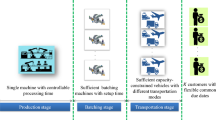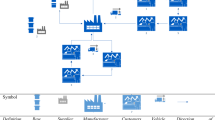Abstract
This research answers three current supply chain issues: demand variability, disruptions, and sustainability. We develop a multi-objective supply chain network model integrating inventory decisions for each echelon under demand uncertainty and limited production capacity. The model describes the optimal productions and allocations in normal and disrupted conditions. The objective function is to minimize the total supply chain cost and emissions. To handle the complexity, we proposed a priority-based Non-dominating Sorting Genetic Algorithm II (pb-NSGA-II) and priority-based Multi-Objective Particle Swarm Optimization (pb-MOPSO) with four novel decoding procedures to accommodate the priority: ordering cost, carbon emission, backtrack priority-based decoding, and adaptive decoding. The experiments indicate that at low disruption duration, the supply chain network design (SCND) is not affected by the disruption due to the existence of safety stock. However, the SCND starts rescheduling and reallocating its demands at medium and high disruption durations.















Similar content being viewed by others
Data availability
All the data supporting the findings of this study are available within the article.
References
Watson M, Lewis S, Cacioppi P, Jayaraman J (2013) Supply chain network design: Applying optimization and analytics to the global supply chain. Pearson Education, New Jersey
Melnyk SA, Narasimhan R, Decampos H (2014) Supply chain design: issues, challenges, frameworks and solutions. Int J Prod Res 52(7):1887–1896. https://doi.org/10.1080/00207543.2013.787175
Statista (2020) Which conditions make businesses most vulnerable to value chain disruptions, including COVID-19? https://www.statista.com/statistics/1155422/conditions-supply-chain-vulnerability-gvc/?locale=en. Assessed 18 Jan 2023
Puga MS, Tancrez J (2017) A heuristic algorithm for solving large location–inventory problems with demand uncertainty. Eur J Oper Res 259(2):413–423. https://doi.org/10.1016/j.ejor.2016.10.037
Hiassat A, Diabat A, Rahwan I (2017) A genetic algorithm approach for location-inventory-routing problem with perishable products. J Manuf Syst 42:93–103. https://doi.org/10.1016/j.jmsy.2016.10.004
Zheng X, Yin M, Zhang Y (2019) Integrated optimization of location, inventory and routing in supply chain network design. Transp Res Part B: Methodol 121:1–20. https://doi.org/10.1016/j.trb.2019.01.003
Statista (2022a) Supply chain challenges in 2021. https://www.statista.com/statistics/1182057/global-supply-chain-challenges/?locale=en. Assessed 18 Jan 2023
Statista (2022b) Number of supply chain disruptions worldwide from 2019 to 2021. https://www.statista.com/statistics/1267082/supply-chain-disruptions-worldwide/?locale=en. Assessed 18 Jan 2023
Hosseini-Motlagh S, Nami N, Farshadhfar Z (2020) Collection disruption management and channel coordination in a socially concerned closed-loop supply chain: A game theory approach. J Clean Prod 276:1–19. https://doi.org/10.1016/j.jclepro.2020.124173
Gautam P, Khanna A, Jaggi CK (2021) An integrated green supply chain model with product recovery management towards a cleaner system. J Clean Prod 320:1–15. https://doi.org/10.1016/j.jclepro.2021.128850
Ivanov D (2019) Disruption tails and revival policies: a simulation analysis of supply chain design and production-ordering systems in the recovery and post-disruption periods. Comput Ind Eng 127:558–570. https://doi.org/10.1016/j.cie.2018.10.043
Sawik T (2019) Two-period vs. multi-period model for supply chain disruption management. Int J Prod Res 57:1–17. https://doi.org/10.1080/00207543.2018.1504246
Bottani E, Murino T, Schiavo M, Akkerman R (2019) Resilient food supply chain design: modelling framework and metaheuristic solution approach. Comput Ind Eng 135:177–198. https://doi.org/10.1016/j.cie.2019.05.011
Masruroh NA, Putra RKE, Mulyani YP, Rifai AP (2022) Strategic insights into recovery from supply chain disruption: a multi-period production planning model. J Oper Res Soc 56:227–240. https://doi.org/10.1080/01605682.2022.2115414
Chen J, Wang H, Zhong RY (2021) A supply chain disruption recovery strategy considering product change under COVID-19. J Manuf Syst 60:920–927. https://doi.org/10.1016/j.jmsy.2021.04.004
Gholami-Zanjani SM, Jabalameli MS, Pishvaee MS (2021) A resilient-green model for multi-echelon meat supply chain planning. Comput Ind Eng 152:107018. https://doi.org/10.1016/j.cie.2020.107018
Dulebenets MA (2021) An Adaptive polyploid memetic algorithm for scheduling trucks at a cross-docking terminal. Inf Sci 565:390–421. https://doi.org/10.1016/j.ins.2021.02.039
Kordasiabi MC, Gholizadeh H, Khakifirooz M, Fathi M (2022) Robust-heuristic-based optimisation for an engine oil sustainable supply chain network under uncertainty. Int J Prod Res 61(4):1313–1340. https://doi.org/10.1080/00207543.2022.2035010
Karimi SK, Naini SGJ, Sadjadi SJ (2021) An integration of environmental awareness into flexible supply chains: a trade-off between costs and environmental pollution. Environ Sci Pollut Res. https://doi.org/10.1007/s11356-021-13454-z
Gholizadeh H, Goh M, Fazlollahtabar H, Mamashli Z (2022) Modelling uncertainty in sustainable-green integrated reverse logistics network using metaheuristics optimization. Comput Ind Eng 163:107828. https://doi.org/10.1016/j.cie.2021.107828
Pasha J, Nwodu AL, Fathollahi-Fard AM, Tian G, Li Z, Wang H, Dulebenets MA (2022) Exact and metaheuristic algorithms for the vehicle routing problem with a factory-in-a-box in multi-objective settings. Adv Eng Inform 52:101623. https://doi.org/10.1016/j.aei.2022.101623
Khoei MA, Aria SS, Gholizadeh H, Goh M, Cheikhrouhou N (2022) Big data-driven optimization for sustainable reverse logistics network design. J Ambient Intell Human Comput. https://doi.org/10.1007/s12652-022-04357-z
Pahlevan SM, Hosseini SMS, Goli A (2021) Sustainable supply chain network design using products’ life cycle in the aluminum industry. Environ Sci Pollut Res. https://doi.org/10.1007/s11356-020-12150-8
Yavari M, Zaker H (2019) An integrated two-layer network model for designing a resilient green-closed loop supply chain of perishable products under disruption. J Clean Prod 230:198–218. https://doi.org/10.1016/j.jclepro.2019.04.130
Mehrjerdi YZ, Shafiee M (2020) A resilient and sustainable closed-loop supply chain using multiple sourcing and information sharing strategies. J Clean Prod 289:125141. https://doi.org/10.1016/j.jclepro.2020.125141
Hamedirostami A, Goli A, Gholipour-Kanani Y (2022) Green cross-dock based supply chain network design under demand uncertainty using new metaheuristic algorithms. J Ind Manag Optim 18(5):3103–3131. https://doi.org/10.3934/jimo.2021105
Jahani H, Gholizadeh H (2022) A flexible closed loop supply chain design considering multi-stage manufacturing and queuing based inventory optimization. IFAC-Papers Online 55(10):1325–1330. https://doi.org/10.1016/j.ifacol.2022.09.574
Darom NA, Hishamuddin H, Ramli R, Nopiah ZM (2018) An inventory model of supply chain disruption recovery with safety stock and carbon emission consideration. J Clean Prod 197:1011–1021. https://doi.org/10.1016/j.jclepro.2018.06.246
Dulebenets MA, Moses R, Ozguven EE, Vanli A (2017) Minimizing carbon dioxide emissions due to container handling at marine container terminals via hybrid evolutionary algorithms. IEEE Access 5:8131–8147. https://doi.org/10.1109/ACCESS.2017.2693030
Bo H, Chen Y, Li H, Han P, Qi L (2021) Time-sensitive supply chain disruption recovery and resource sharing incentive strategy. J Manag Sci Eng 6(2):165–176. https://doi.org/10.1016/j.jmse.2021.03.004
Paul SK, Sarker R, Essam D (2017) A quantitative model for disruption Mitigation in a supply chain. Eur J Oper Res 257(3):881–895. https://doi.org/10.1016/j.ejor.2016.08.035
Malik AI, Sarkar B (2020) Disruption management in a constrained multi-product imperfect production system. J Manuf Syst 56:227–240. https://doi.org/10.1016/j.jmsy.2020.05.015
Hishamuddin H, Sarker RA, Essam D (2013) A recovery model for a two-echelon serial supply chain with consideration of transportation disruption. Comput Ind Eng 64(2):552–561. https://doi.org/10.1016/j.cie.2012.11.012
Qi X, Bard JF, Yu G (2004) Supply chain coordination with demand disruptions. Omega 32(4):301–312. https://doi.org/10.1016/j.omega.2003.12.002
Ivanov D, Dolgui A, Sokolov B, Ivanova M (2017) Literature review on disruption recovery in the supply chain. Int J Prod Res 55(20):6158–6174. https://doi.org/10.1080/00207543.2017.1330572
Rezapour S, Farahani RZ, Pourakbar M (2017) Resilient supply chain network design under competition: A case study. Eur J Oper Res 259(3):1017–1035. https://doi.org/10.1016/j.ejor.2016.11.041
Hishamuddin H, Mohamad Sobri FM, Nur Ghafar FA, and Noraida Darom AM (2019) A recovery model for an EPQ system subject to supply disruption with consideration of safety stock. In: International Conference on Industrial Engineering and Applications, pp 240–245. https://doi.org/10.1109/IEA.2019.8715204
Ganeshan R, Harrison TP (2002) An introduction to supply chain management. Penn State University, Departement of Management Science and Information Systems
Kamalahmadi M, Parast MM (2017) An assessment of supply chain disruption mitigation strategies. Int J Prod Econ 184:210–230. https://doi.org/10.1016/j.ijpe.2016.12.011
Yan S, Ji X (2020) Supply chain network design under the risk of uncertain disruptions. Int J Prod Res 58(6):1724–1740. https://doi.org/10.1080/00207543.2019.1696999
Hu H, Guo S, Qin Y, Lin W (2023) Two-stage stochastic programming model and algorithm for mitigating supply disruption risk on aircraft manufacturing supply chain network design. Comput Ind Eng 175:108880. https://doi.org/10.1016/j.cie.2022.108880
Winati FD (2020) Pengembangan model optimasi jaringan rantai pasok dengan mempertimbangkan inventory control. Thesis, Universitas Gadjah Mada
Gen M, Altiparmak F, Lin L (2006) A genetic algorithm for two-stage transportation problem using priority-based encoding. OR Spectr 28:337–354. https://doi.org/10.1007/s00291-005-0029-9
Deb K, Pratap A, Agarwal S, Meyarivan T (2002) A Fast and Elitist Multi-objective Genetic Algorithm: NSGA-II. IEEE Trans Evol Comput 6(2):182–197. https://doi.org/10.1109/4235.996017
Katoch S, Chauhan S, Kumar V (2020) A review on genetic algorithm: past, present, and future. Multimed Tools Appl 80(5):8091–8126. https://doi.org/10.1007/s11042-020-10139-6
Kuo RJ, Gosumolo M, Zulvia FE (2019) Multi-objective particle swarm optimization algorithm using adaptive archive grid for numerical association rule mining. Neural Comput Appl 31:3559–3572. https://doi.org/10.1007/s00521-017-3278-z
Govindan K, Jafarian A, Khodaverdi R, Devika K (2014) Two-echelon multiple-vehicle location–routing problem with time windows for optimization of sustainable supply chain network of perishable food. Int J Prod Econ 152:9–28. https://doi.org/10.1016/j.ijpe.2013.12.028
Acknowledgements
The study is funded by the Ministry of Education, Culture, Research and Technology of the Republic of Indonesia, grant number 018/E5/PG.02.00.PT/2022 and 1718/UN1/DITLIT/Dit-Lit/PT.01.03/2022.
Author information
Authors and Affiliations
Corresponding author
Ethics declarations
Conflict of interest
The authors declare that they have no conflict of interest.
Additional information
Publisher's Note
Springer Nature remains neutral with regard to jurisdictional claims in published maps and institutional affiliations.
Rights and permissions
Springer Nature or its licensor (e.g. a society or other partner) holds exclusive rights to this article under a publishing agreement with the author(s) or other rightsholder(s); author self-archiving of the accepted manuscript version of this article is solely governed by the terms of such publishing agreement and applicable law.
About this article
Cite this article
Masruroh, N.A., Rifai, A.P., Mulyani, Y.P. et al. Priority-based multi-objective algorithms for green supply chain network design with disruption consideration. Prod. Eng. Res. Devel. 18, 117–140 (2024). https://doi.org/10.1007/s11740-023-01220-8
Received:
Accepted:
Published:
Issue Date:
DOI: https://doi.org/10.1007/s11740-023-01220-8




